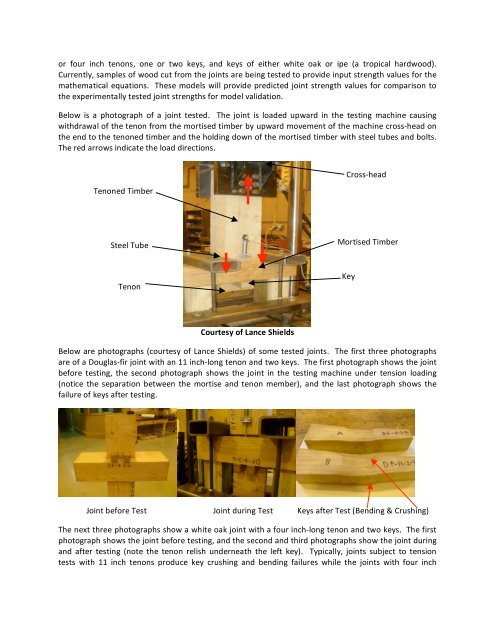Keys Mortise Through Tenon Mortised Timber King Post Collar ...
Keys Mortise Through Tenon Mortised Timber King Post Collar ...
Keys Mortise Through Tenon Mortised Timber King Post Collar ...
Create successful ePaper yourself
Turn your PDF publications into a flip-book with our unique Google optimized e-Paper software.
or four inch tenons, one or two keys, and keys of either white oak or ipe (a tropical hardwood). <br />
Currently, samples of wood cut from the joints are being tested to provide input strength values for the <br />
mathematical equations. These models will provide predicted joint strength values for comparison to <br />
the experimentally tested joint strengths for model validation. <br />
Below is a photograph of a joint tested. The joint is loaded upward in the testing machine causing <br />
withdrawal of the tenon from the mortised timber by upward movement of the machine cross‐head on <br />
the end to the tenoned timber and the holding down of the mortised timber with steel tubes and bolts. <br />
The red arrows indicate the load directions. <br />
<strong>Tenon</strong>ed <strong>Timber</strong> <br />
Steel Tube <br />
<strong>Tenon</strong> <br />
Courtesy of Lance Shields <br />
Below are photographs (courtesy of Lance Shields) of some tested joints. The first three photographs <br />
are of a Douglas‐fir joint with an 11 inch‐long tenon and two keys. The first photograph shows the joint <br />
before testing, the second photograph shows the joint in the testing machine under tension loading <br />
(notice the separation between the mortise and tenon member), and the last photograph shows the <br />
failure of keys after testing. <br />
Joint before Test Joint during Test <strong>Keys</strong> after Test (Bending & Crushing) <br />
The next three photographs show a white oak joint with a four inch‐long tenon and two keys. The first <br />
photograph shows the joint before testing, and the second and third photographs show the joint during <br />
and after testing (note the tenon relish underneath the left key). Typically, joints subject to tension <br />
tests with 11 inch tenons produce key crushing and bending failures while the joints with four inch <br />
<br />
Cross‐head <br />
<strong>Mortise</strong>d <strong>Timber</strong> <br />
Key <br />


